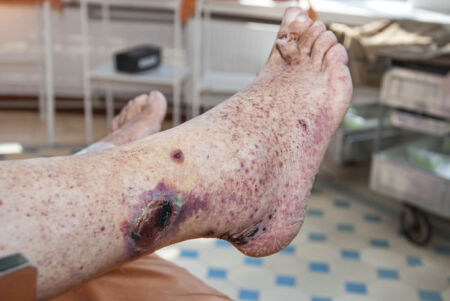
Varicose veins can be a significant cosmetic embarrassment. In addition to the unsightly bulging vessels that appear on your lower legs, you may also notice changes to your skin over time. These skin changes can become more than unattractive, they can also lead to itching, irritation and skin sores if left unchecked. It is important to understand the link between varicose veins and skin changes, as well as the treatment options that can eliminate both of these concerns.
Varicose veins are frequently caused by an underlying condition known as venous insufficiency. This condition occurs when veins become damaged or wear out over time, allowing blood to pool inside the veins. As a result, the vessels can swell and become varicose. The problem is most likely to occur in the lower leg veins, because these hardworking veins are the most likely to suffer damage from pushing blood all the way from the feet back up to the heart.
The reflux of blood back into the vein increases pressure inside the vein, causing it to swell. That pressure can also negatively affect the tissue and skin surrounding the vessel. When pressure is affected, skin and tissue do not receive sufficient oxygen and nutrients to remain as healthy as possible.
That lack of nutrients and oxygen can take a significant toll on the skin, one that will become visible over time. People with varicose veins are more vulnerable to skin conditions like stasis dermatitis, characterized by scaly skin, thickening of the skin and discoloration. The skin in the area may become irritated, itchy and prone to cracking.
When the skin begins to crack, bacteria can get into the skin and cause an infection known as cellulitis. Cellulitis symptoms include skin that is warm and tender to the touch, red and swollen. Cellulitis is typically treated with antibiotics that fight the bacteria and clear up the skin.
The longer skin changes are allowed to progress, the more dangerous they can become. If cellulitis develops, it can be very challenging to treat and may require hospitalization and antibiotics intravenously to get rid of the infection completely. Another risk associated with stasis dermatitis is an open sore that often starts from a small scratch or skin prick and eventually expands.
Known as venous ulcers, these sores can grow quite large and become very difficult to treat. Ongoing treatment over a period of months is often the only way to get rid of these stubborn sores that are prone to infection and recurrence.
When skin problems are caused by varicose veins, the first course of treatment is often to eliminate the veins themselves. Today, there are many minimally-invasive vein treatments that eradicate varicose veins and their uncomfortable symptoms. If treated early, skin problems may be prevented if they haven’t already occurred, or reversed if symptoms have developed.
The staff at Center for Vein Restoration offers a variety of vein treatments that allow us to customize your procedure to your specific needs. All of our procedures are performed on an outpatient basis and patients are usually back to regular activities the same day or the day after treatment. To find out which vein treatment is right for you, contact Center for Vein Restoration today.